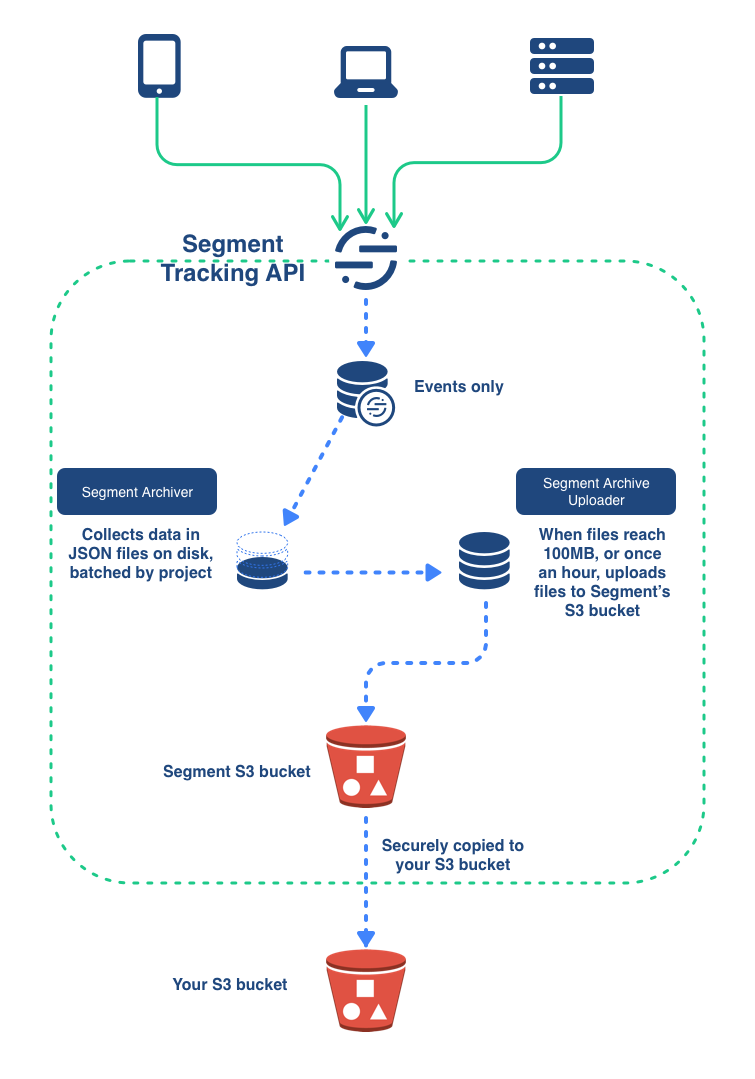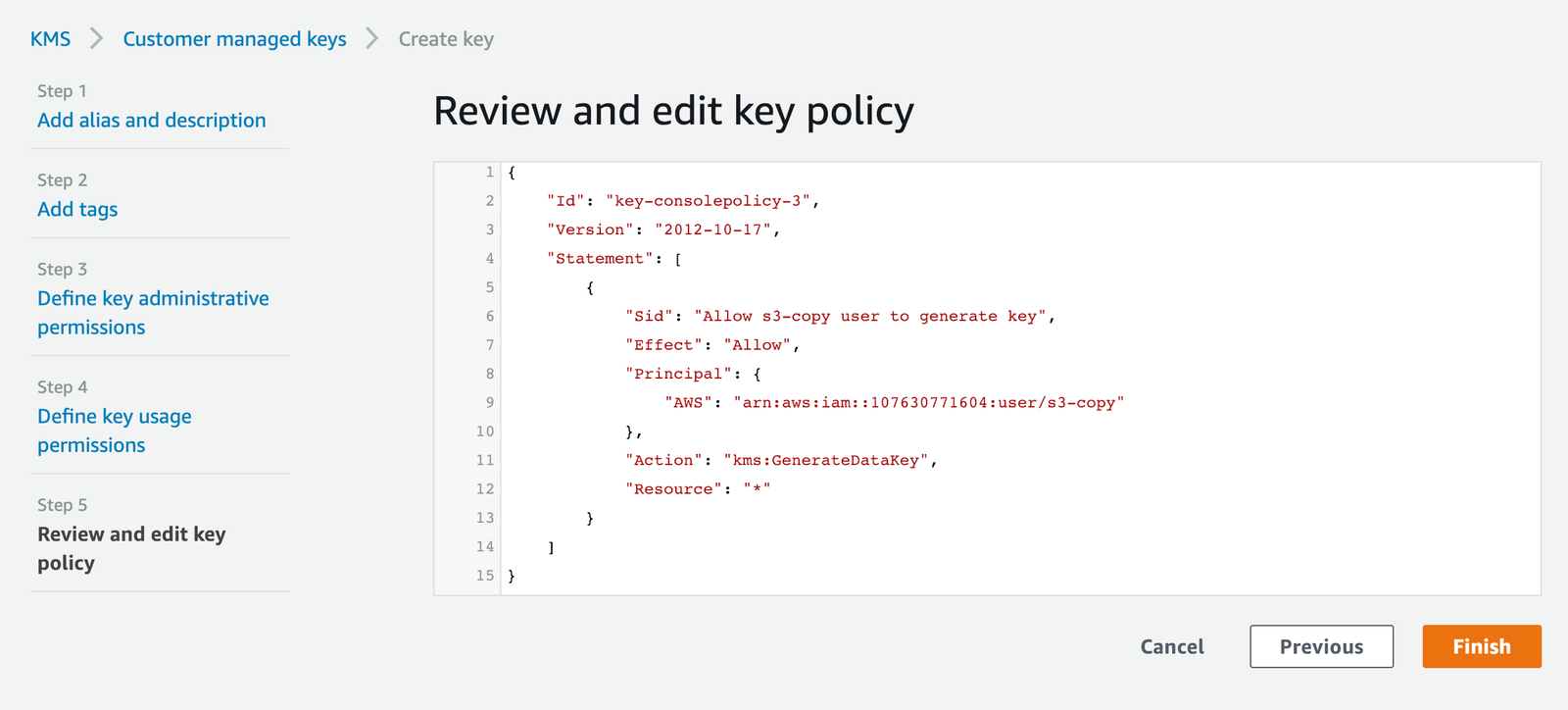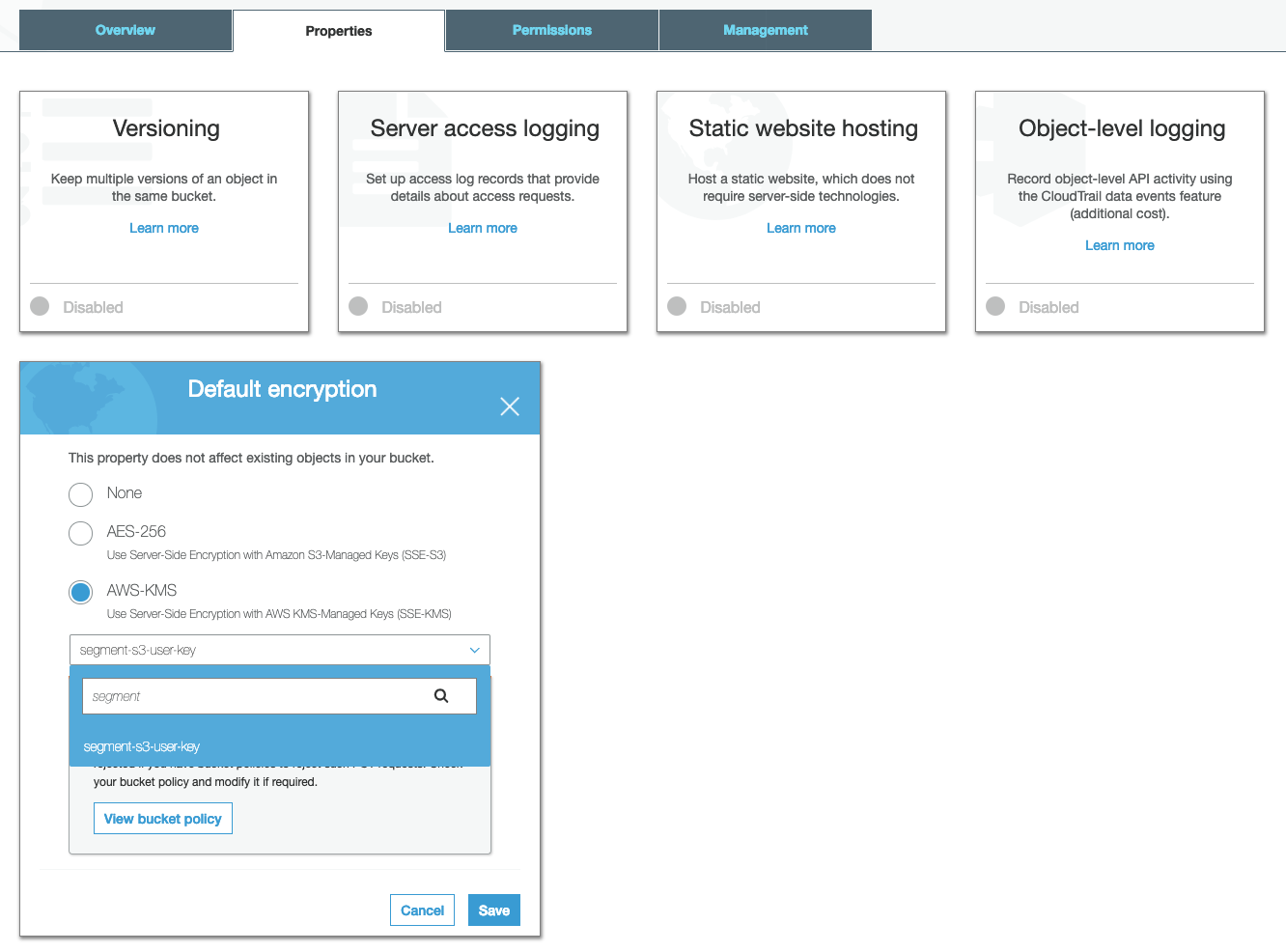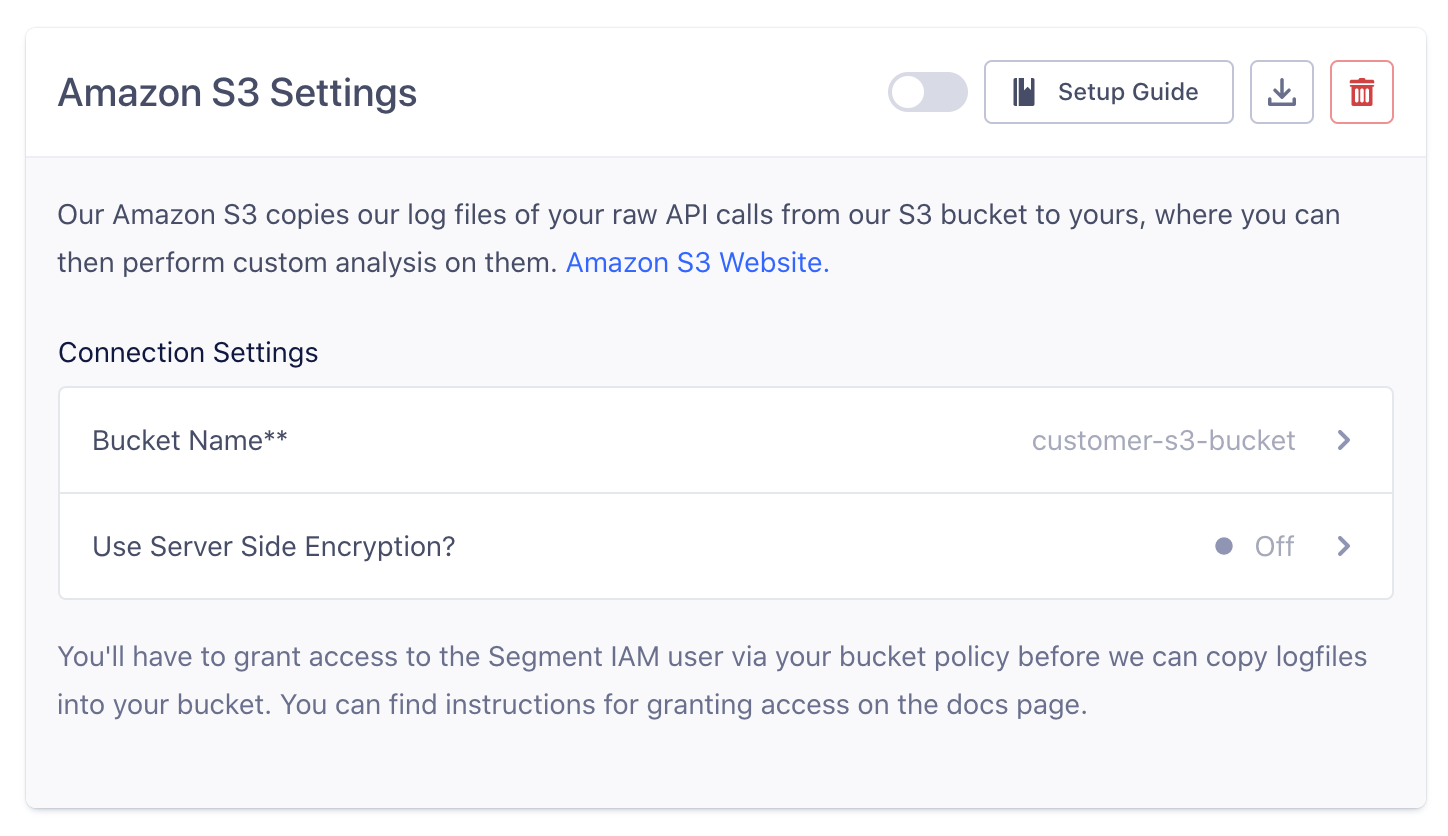Amazon S3 Destination
The Amazon S3 destination will enter Limited Access on February 8, 2022
After the Amazon S3 destination enters Limited Access, you will no longer be able to modify existing Amazon S3 destination instances, create new Amazon S3 instances, or re-enable a disabled Amazon S3 instance. Existing Amazon S3 instances will continue to receive data.
Migrate to the AWS S3 destination to continue storing data in AWS. For more information about migration to AWS S3, see the AWS S3 destination documentation.
Migrating from Amazon S3 to AWS S3
Segment recommends you migrate from the Amazon S3 destination to the AWS S3 destination.
Benefits of using the new AWS S3 destination include:
- Compliance with AWS best practice of using an external ID to grant Segment access to your AWS resources. This improves the privacy and security of your customer data.
- Availability in both the US and EU regions, unlike the Amazon S3 destination, which was available only in the US. This ensures customer data resides in your preferred region.
To migrate to the AWS S3 destination, follow the instructions outlined in the “Migrate an existing destination” section of the AWS S3 destination documentation.
You can view the AWS S3 destination in the Storage Destinations catalog.

You need to migrate to the new S3 destination before you disable your legacy destination to ensure Segment continues to deliver data to your S3 bucket.
Getting Started
The Amazon S3 destination puts the raw logs of the data Segment receives into your S3 bucket, encrypted, no matter what region the bucket is in.
Segment copies data into your bucket every hour around the :40 minute mark. You may see multiple files over a period of time depending on the amount of data Segment copies.
Keep in mind that Amazon S3 works in a different way from most other destinations. Using a destinations selector like the integrations object does not affect events with Amazon S3.
The diagram below illustrates how the S3 destination works.
The Segment Tracking API processes data from your sources, and collects the Events in batches. When these batches reach a 100 MB, or once per hour, a Segment initiates a process which uploads them to a secure Segment S3 bucket, from which they are securely copied to your own S3 bucket.

Required Steps
- Create a bucket in your preferred region.
- Create a folder “segment-logs” inside the bucket.
- Edit your bucket policy to allow Segment to copy files into the bucket:
{
"Version": "2008-10-17",
"Id": "Policy1425281770533",
"Statement": [
{
"Sid": "AllowSegmentUser",
"Effect": "Allow",
"Principal": {
"AWS": "arn:aws:iam::107630771604:user/s3-copy"
},
"Action": "s3:PutObject",
"Resource": "arn:aws:s3:::YOUR_BUCKET_NAME/segment-logs/*"
}
]
}
The Resource property string must end with /*.
Specifically, this adds the ability to s3:PutObject for the Segment s3-copy user for your bucket.
If you have server-side encryption enabled, see the required configuration.
You can edit your bucket policy in the AWS management console by right-clicking the bucket and then selecting the “edit policy” option.
Lastly, enable the Amazon S3 destination in your Segment destination catalog, and put in your bucket name in the destination settings. It will take about an hour to start receiving data.
Data format
Segment stores logs as gzipped, newline-separated JSON containing the full call information. For a list of supported properties, see the Segment Spec documentation.
Segment groups logs by day, and names them using the following format:
s3://{bucket}/segment-logs/{source-id}/{received-day}/filename.gz
The received-day refers to the UTC date unix timestamp, that the API receives the file, which makes it easy to find all calls received within a certain timeframe.
Encryption
This section contains information for enabling encryption on your S3 bucket.
Server-Side Encryption with Amazon S3-Managed Keys (SSE-S3)
Segment supports optional, S3-managed Server-Side Encryption, which you can disable or enable from the Destination Configuration UI. By default, the destination now automatically enables encryption, and Segment recommends that you continue to encrypt. If you’ve had the S3 destination enabled since before October 2017, you might need to enable encryption manually on your bucket.
While most client libraries transparently decrypt the file when fetching it, you should make sure that any applications that consume data in the S3 bucket are ready to decrypt the data before you enable this feature. When you’re ready, you can enable encryption from the setting in the destination configuration UI.
Server-Side Encryption with AWS KMS-Managed Keys (SSE-KMS)
Segment can also write to S3 buckets with Default Encryption set to AWS-KMS. This ensures that objects written to your bucket are encrypted using customer managed keys created in your AWS Key Management Service (KMS). Follow the steps below to enable encryption using AWS KMS Managed Keys:
Create a new customer-managed key and grant the Segment user permissions to generate new keys
The Segment user must have the permission to GenerateDataKey from your AWS Key Management Service. Here is a sample policy document that grants the Segment user the necessary permissions.
{
"Version": "2012-10-17",
"Id": "key-consolepolicy-3",
"Statement": [
{
"Sid": "Allow Segment S3 user to generate key",
"Effect": "Allow",
"Principal": {
"AWS": "arn:aws:iam::107630771604:user/s3-copy"
},
"Action": "kms:GenerateDataKey",
"Resource": "*"
}
]
}

Update S3 bucket default encryption property
The target S3 bucket should have the “Default encryption” property enabled and set to AWS-KMS. Choose the customer-managed key generated in the above step for encryption.

Disable ServerSideEncryption in Segment S3 Destination settings
Disable the Server Side Encryption setting in the Segment destination configuration. This allows you to enable bucket-level encryption, so Amazon can encrypt objects using KMS managed keys.

Enforcing encryption
To further secure your bucket by ensuring that all files upload with the encryption flag present, you can add to the bucket policy to strictly enforce that all uploads trigger encryption.
Segment recommends doing this as a best practice. The following policy strictly enforces upload encryption with Amazon S3-Managed keys.
{
"Version": "2008-10-17",
"Id": "Policy1425281770533",
"Statement": [
{
"Sid": "AllowSegmentUser",
"Effect": "Allow",
"Principal": {
"AWS": "arn:aws:iam::107630771604:user/s3-copy"
},
"Action": "s3:PutObject",
"Resource": "arn:aws:s3:::YOUR_BUCKET_NAME/segment-logs/*"
},
{
"Sid": "DenyIncorrectEncryptionHeader",
"Effect": "Deny",
"Principal": "*",
"Action": "s3:PutObject",
"Resource": "arn:aws:s3:::YOUR_BUCKET_NAME/*",
"Condition": {
"StringNotEquals": {
"s3:x-amz-server-side-encryption": "AES256"
}
}
},
{
"Sid": "DenyUnEncryptedObjectUploads",
"Effect": "Deny",
"Principal": "*",
"Action": "s3:PutObject",
"Resource": "arn:aws:s3:::YOUR_BUCKET_NAME/*",
"Condition": {
"Null": {
"s3:x-amz-server-side-encryption": "true"
}
}
}
]
}
Region
The Amazon S3 destination only supports workspaces in the US region. Workspaces outside of the US can’t connect to this destination. If you wish to connect to a different region use Segment’s new AWS S3 destination instead.
Segment infers the region of your bucket when data is copied to it, so you don’t need to specify a bucket region in your configuration. If you’re using VPC Endpoints for your S3 bucket, make sure you configure the endpoint in the same region as your bucket. You can find more information on this in the AWS S3 docs here.
Custom Path Prefix
To use a custom key prefix for the files in your bucket, append the path to the bucket name in the Segment S3 destination configuration UI. For example, a bucket string mytestbucket/path/prefix would result in data copying to /path/prefix/segment-logs/{source-id}/{received-day}/.
How can I download the data from my bucket?
Segment recommends using the AWS CLI and writing a short script to download specific days, one at a time. The AWS CLI is faster than s3cmd because it downloads files in parallel.
S3 transparently decompresses the files for most clients. To access the raw gzipped data you can programmatically download the file using the AWS SDK and setting ResponseContentEncoding: none. This functionality isn’t available in the AWS CLI). You can also manually remove the metadata on the file (Content-Type: text/plain and Content-Encoding: gzip) through the AWS interface, which allows you to download the file as gzipped.
To configure the AWS CLI, see Amazon’s documentation here. For linux systems, run the following command:
$ sudo apt-get install awscli
Then configure AWS CLI with your Access Key ID and Secret Access Key. You can create or find these keys in your Amazon IAM user management console. Then run the following command which will prompt you for the access keys:
$ aws configure
To see a list of the most recent log folders:
$ aws s3 ls s3://{bucket}/segment-logs/{source-id}/ | tail -10
To download the files for a specific day:
$ aws s3 sync s3://{bucket}/segment-logs/{source-id}/{received-day} .
Or to download all files for a source:
$ aws s3 sync s3://{bucket}/segment-logs/{source-id} .
To put the files in a specific folder replace the . at the end (“current directory”) with the desired directory like ~/Downloads/logs.
Engage
As mentioned above, the Amazon S3 destination works differently than other destinations in Segment. As a result, Segment sends all data from a Engage source to S3 during the sync process, not only the connected audiences and traits.
You can send computed traits and audiences generated using Engage to this destination as a user property.
For user-property destinations, Segment sends an identify call to the destination for each user added and removed. The property name is the snake_cased version of the audience name, with a true/false value to indicate membership. For example, when a user first completes an order in the last 30 days, Engage sends an Identify call with the property order_completed_last_30days: true. When the user no longer satisfies this condition (for example, it’s been more than 30 days since their last order), Engage sets that value to false.
When you first create an audience, Engage sends an Identify call for every user in that audience. Later audience syncs send updates for users whose membership has changed since the last sync.
This page was last modified: 21 Apr 2023
Need support?
Questions? Problems? Need more info? Contact Segment Support for assistance!